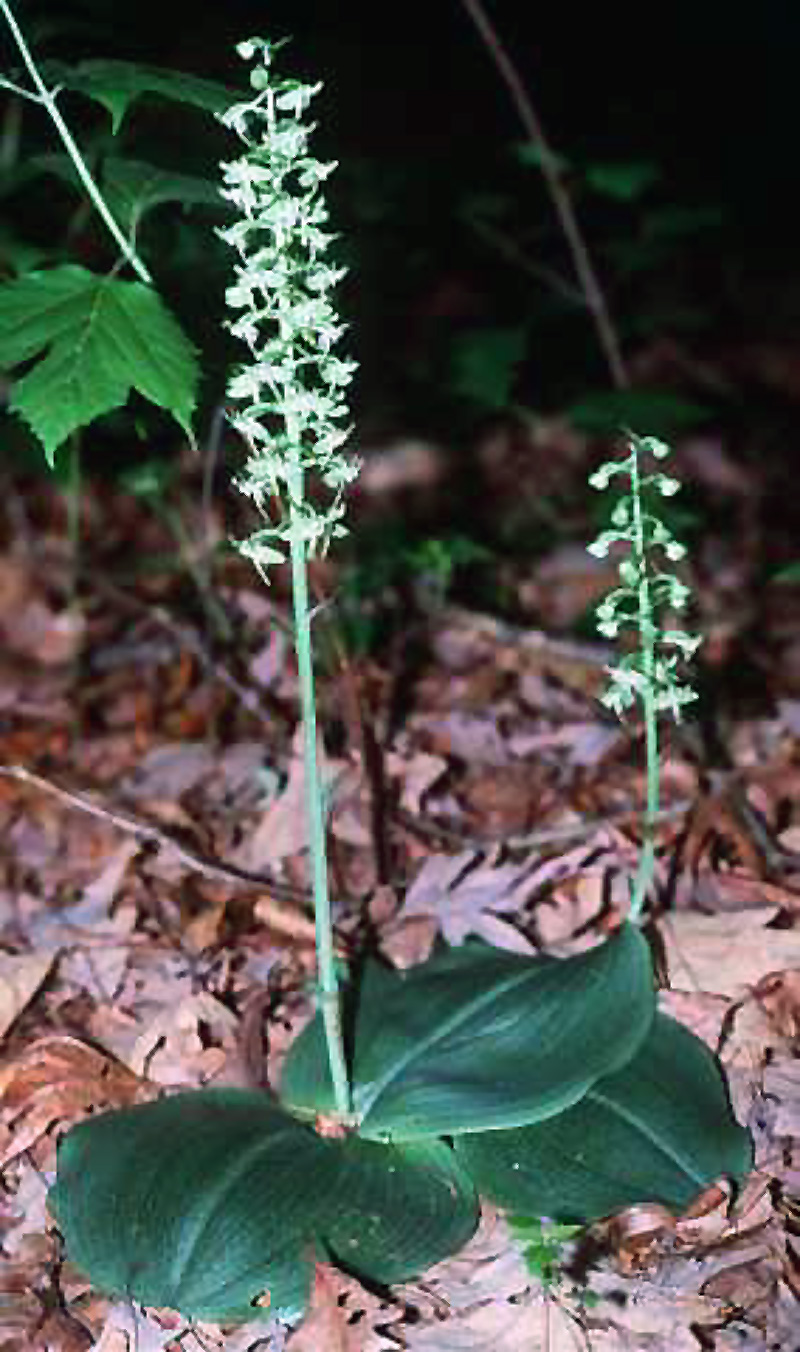Plant of the Week
 Range map of Platanthera orbiculata. States are colored green where the species may be found.
Range map of Platanthera orbiculata. States are colored green where the species may be found.
 Round-leaved Rein Orchid (Platanthera orbiculata) flower. USDA Photo.
Round-leaved Rein Orchid (Platanthera orbiculata) flower. USDA Photo.
 Round-leaved Rein Orchid (Platanthera orbiculata) flowers and stem. USDA Photo.
Round-leaved Rein Orchid (Platanthera orbiculata) flowers and stem. USDA Photo.
 Round-leaved Rein Orchid (Platanthera orbiculata) plant. USDA Photo.
Round-leaved Rein Orchid (Platanthera orbiculata) plant. USDA Photo.
Round-leaved Rein Orchid (Platanthera orbiculata)
By Tom Heutte, Forest Botanist, Chippewa National Forest, Minnesota
We often tend to associate orchids with lofty rain forest canopies or hothouses maintained by eccentric geniuses. However, many orchids can be found in forests and bogs throughout North America in all but the driest parts of the continent. Most of them are not showy prima donnas but inconspicuous beauties of forests and wetlands that require a little knowledge and searching to notice.
Orchids are considered by evolutionary biologists to be the most advanced family of flowering plants. This position is due to the complexity of their flower parts driving relationships that they have developed with their pollinators. These elaborate mechanisms for attracting pollinators are a marvel of mechanical complexity unrivalled in the plant kingdom.
One of the most widespread of these is the round-leaved rein orchid also known as Platanthera orbiculata by botanists, the flat leaved orchid, dinner plate orchid (by the hill people of the southern Appalachians), or its code name “PLOR4” by rare plant database managers. It can be found in a variety of habitats as varied as the rainforests of southeastern Alaska and the Black Hills of South Dakota and Wyoming.
Widespread but never abundant, its picky but varied choices of habitat can confound those who seek to explain its quirky distribution. While its survival is secure in parts of its range, it is considered endangered in several states and has been extirpated from Connecticut and Indiana.
With its diminutive flowers and a pair of large round leaves that sit flat on the forest floor, it has a presence in the forest that is both striking and subtle. The flowers are a brilliant white, but unlike the better-known lady’s slipper orchids, they require a magnifying lens to fully appreciate their complex beauty.
This orchid is a perennial herb with a pair of glossy leathery leaves that emerge in late spring from a thick underground stem (rhizome). Later in summer it sends up a spike of complex, tiny flowers that mature into capsules full of tiny seeds in late summer. It has the curious habit of being able to go dormant for more than a year at a time, waiting out years when growing conditions are less than ideal.
If you chance on one of these plants in the wild, please do not try to move them. Even if collecting and transplanting is permitted by the landowner or agency, these orchids have an obligatory relationship with fungi in the soil. Orchid seeds are the smallest in the plant kingdom.
These seeds are barely larger than a speck of dust and can be blown far and wide by winds. When they land, they are at a distinct disadvantage because they lack a supply of stored energy, the endosperm, normally found in seeds to nourish the developing embryonic plant. The developing seedling must instead be nursed along by soil fungi which provide it energy to develop into a plant capable of supplying its own needs. This relationship most likely explains much about the round leaved rein orchid’s widespread but scattered distribution. The nature of this relationship is not well characterized, so it is best to leave them in place and, instead of taking them home, show your appreciation for them by helping to conserve habitat for their continued survival.

